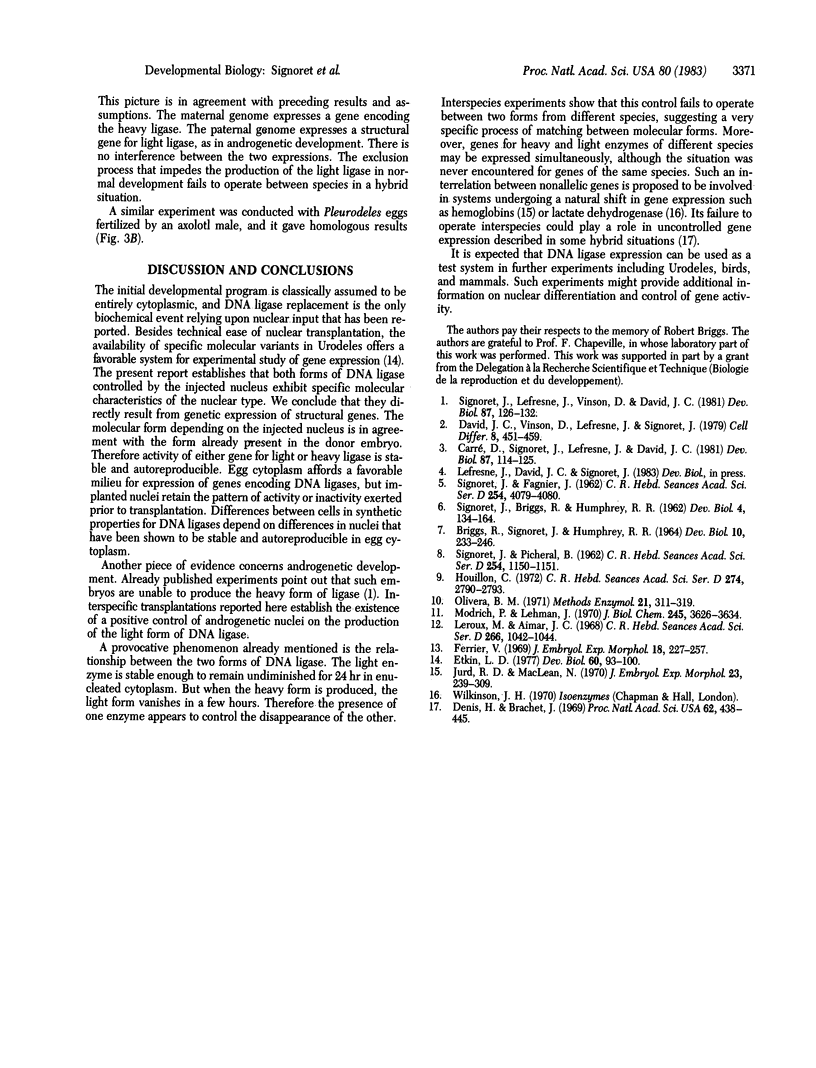Abstract
A light form of DNA ligase (EC 6.5.1.2), the only form present in oocytes of the axolotl (Ambystoma mexicanum), has been shown to be replaced by a heavy form of the enzyme when the egg enters cleavage. This early biochemical event has been assumed to rely on direct nuclear input. Sucrose gradient analysis permits discrimination between enzymes from axolotl and the sharp-ribbed salamander (Pleurodeles waltlii) for both heavy and light enzymatic forms of DNA ligase. Genetic activity of blastula nuclei transplanted in activated cytoplasm has been tested by determination of the enzymatic forms and specific types of DNA ligases when the implanted egg enters cleavage. A blastula nucleus of Pleurodeles in axolotl cytoplasm determines a heavy ligase of the Pleurodeles type. Conversely, a haploid androgenetic nucleus of Pleurodeles in axolotl cytoplasm controls a light ligase of the Pleurodeles type. Reciprocal experiments give homologous results. To our knowledge, this is the earliest nucleus-dependent synthesis revealed in development for any system. The heavy ligase of one species may coexist with the light form of the other species but not with the light form of its own specific type. Inhibition of the production of the heavy form for one genome results in the expression of the light form. We conclude that genetic control of DNA ligase in very early development involves structural genes for heavy and light forms of enzyme, with an exclusion process operating an alternative expression of corresponding genes. This exclusion relationship between nonallelic genes is species specific.
Full text
PDF



Selected References
These references are in PubMed. This may not be the complete list of references from this article.
- BRIGGS R., SIGNORET J., HUMPHREY R. R. TRANSPLANTATION OF NUCLEI OF VARIOUS CELL TYPES FROM NEURULAE OF THE MEXICAN AXOLOTL (AMBYSTOMA MEXICANUM). Dev Biol. 1964 Oct;10:233–246. doi: 10.1016/0012-1606(64)90043-0. [DOI] [PubMed] [Google Scholar]
- Carré D., Signoret J., Lefresne J., David J. C. Enzyme involved in DNA replication in the axolotl. I. Analysis of the forms and activities of DNA polymerase and DNA ligase during development. Dev Biol. 1981 Oct 15;87(1):114–125. doi: 10.1016/0012-1606(81)90065-8. [DOI] [PubMed] [Google Scholar]
- David J. C., Vinson D., Lefresne J., Signoret J. Evidence for a DNA ligase change related to early cleavage in axolotl egg. Cell Differ. 1979 Dec;8(6):451–459. doi: 10.1016/0045-6039(79)90041-1. [DOI] [PubMed] [Google Scholar]
- Denis H., Brachet J. Gene expression in interspecific hybrids. II. RNA synthesis in the lethal cross Arbacia lixula male x Paracentrotus lividus female. Proc Natl Acad Sci U S A. 1969 Feb;62(2):438–445. doi: 10.1073/pnas.62.2.438. [DOI] [PMC free article] [PubMed] [Google Scholar]
- Etkin L. D. Preferential expression of the maternal allele for alcohol dehydrogenase (ADH) in the amphibian hybrid Ambystoma mexicanum (axolotl) x Ambystoma texanum. Dev Biol. 1977 Oct 1;60(1):93–100. doi: 10.1016/0012-1606(77)90112-9. [DOI] [PubMed] [Google Scholar]
- Ferrier V. Etude cytologique des premiers stades du développement de quelques hybrides létaux d'amphibiens Urodèles. J Embryol Exp Morphol. 1967 Oct;18(2):227–257. [PubMed] [Google Scholar]
- Houillon C. Tolérance des greffes ovariennes entre espèces différentes chez les Amphibiens urodèles; conséquences sur l'émission de pontes hétérologues. C R Acad Sci Hebd Seances Acad Sci D. 1972 May 15;274(20):2790–2793. [PubMed] [Google Scholar]
- Leroux M., Aimar C. Greffe nucléocytoplasmique intergénérique chez deux Amphibiens Urodèles: Amybystoma mexicanum et Pleurodeles waltlii. C R Acad Sci Hebd Seances Acad Sci D. 1968 Mar 4;266(10):1042–1044. [PubMed] [Google Scholar]
- Modrich P., Lehman I. R. Enzymatic joining of polynucleotides. IX. A simple and rapid assay of polynucleotide joining (ligase) activity by measurement of circle formation from linear deoxyadenylate-deoxythymidylate copolymer. J Biol Chem. 1970 Jul 25;245(14):3626–3631. [PubMed] [Google Scholar]
- SIGNORET J., BRIGGS R., HUMPHREY R. R. Nuclear transplantation in the axolotl. Dev Biol. 1962 Feb;4:134–164. doi: 10.1016/0012-1606(62)90037-4. [DOI] [PubMed] [Google Scholar]
- SIGNORET J., FAGNIER J. [Experimental activation of the Pleurodele ovum]. C R Hebd Seances Acad Sci. 1962 Jun 4;254:4079–4080. [PubMed] [Google Scholar]
- SIGNORET J., PICHERAL B. [Transplantation of nuclei in Pleurodeles waltlii Michah]. C R Hebd Seances Acad Sci. 1962 Feb 5;254:1150–1151. [PubMed] [Google Scholar]
- Signoret J., Lefresne J., Vinson D., David J. C. Enzymes involved in DNA replication in the axolotl. II. Control of DNA ligase activity during very early development. Dev Biol. 1981 Oct 15;87(1):126–132. doi: 10.1016/0012-1606(81)90066-x. [DOI] [PubMed] [Google Scholar]


